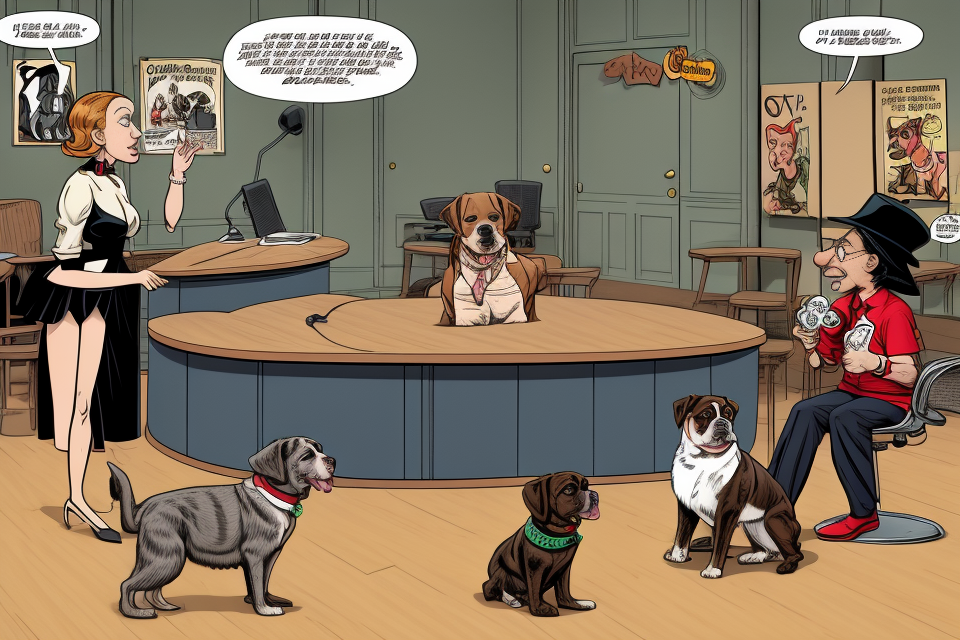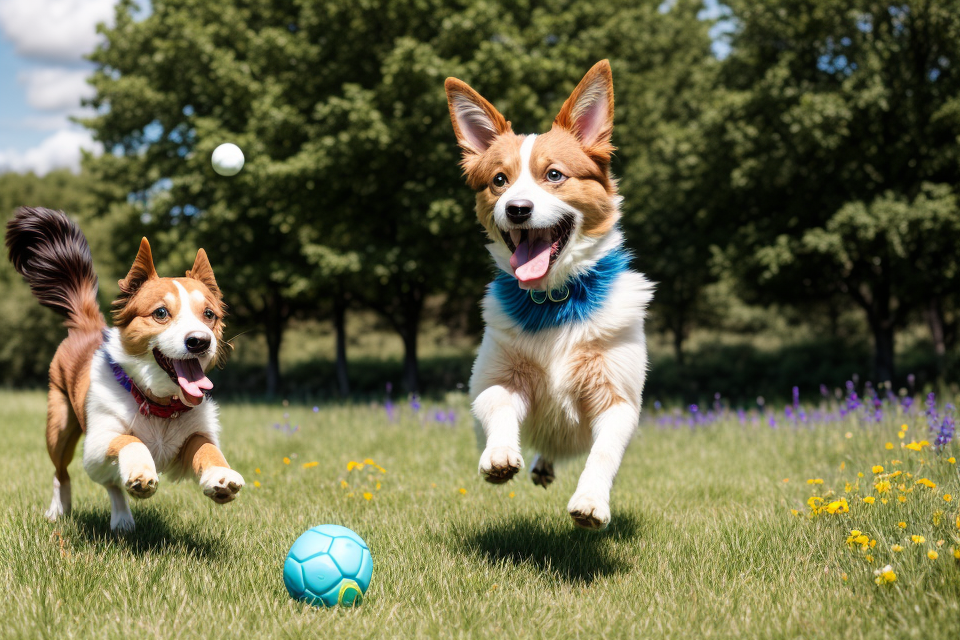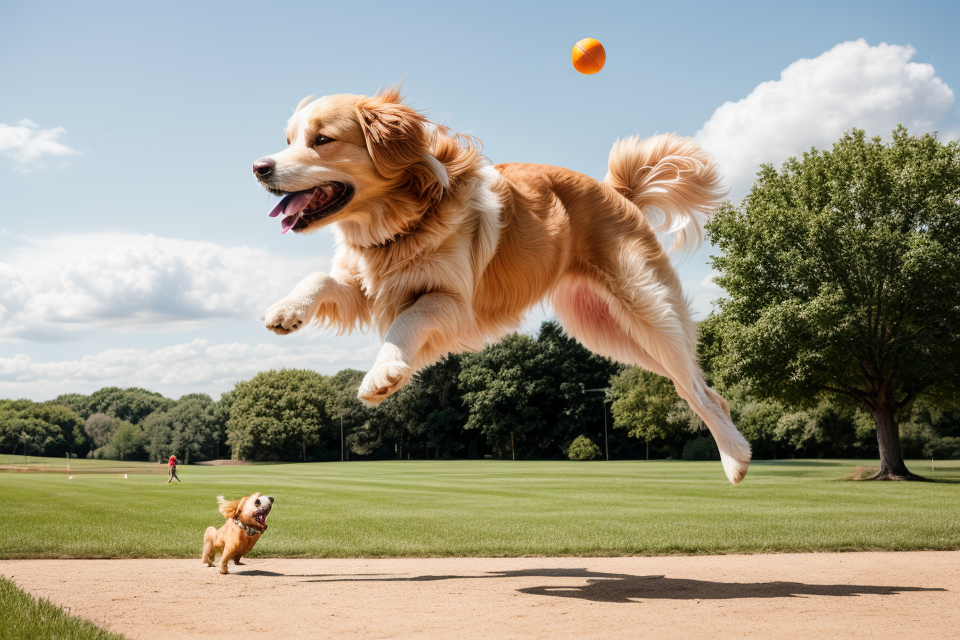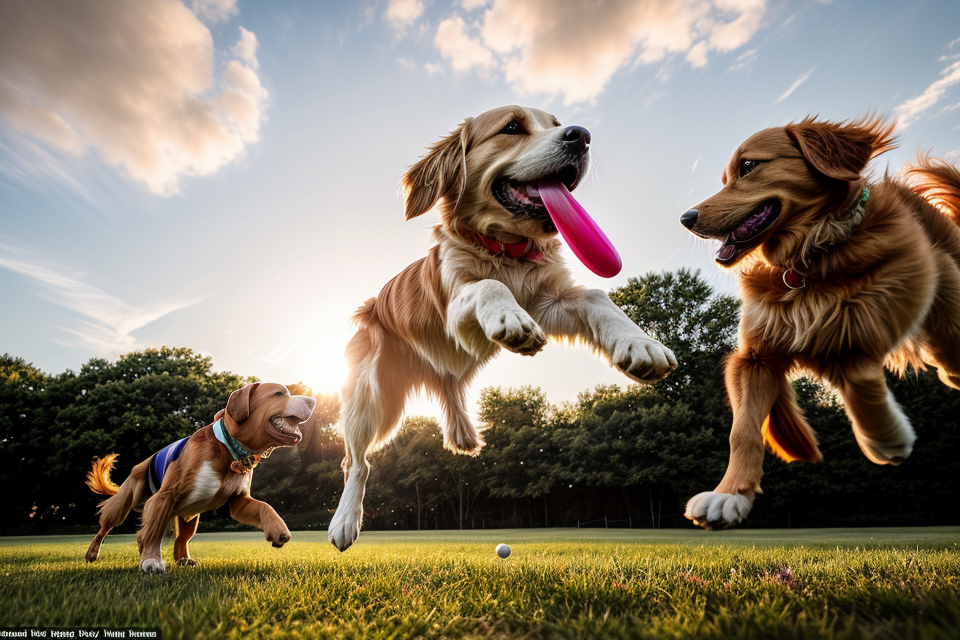The great debate on whether fetch is good for dogs has been a topic of discussion among pet owners and trainers for years. Some believe that fetch is a fun and engaging activity that keeps dogs physically and mentally stimulated, while others argue that it can lead to negative behaviors such as aggression and possessiveness. In this article, we will explore both sides of the debate and provide insights on how to make fetch a positive experience for your furry friend. So, whether you’re a die-hard fetch fan or skeptical about its benefits, read on to find out more!
The Great Debate: Is Fetch Good for Dogs?
Fetch is a popular game played by dogs and their owners, but there is a debate about whether it is good for dogs. Some argue that fetch helps dogs physically and mentally, as it provides exercise and stimulates their natural instinct to retrieve. It also strengthens the bond between the dog and owner. However, others argue that fetch can lead to obsessive behavior and injuries, especially in larger breeds. Ultimately, whether fetch is good for a dog depends on the individual dog’s personality, physical ability, and the owner’s approach to the game.
The Pros of Fetch for Dogs
Mental Stimulation
Fetch is an excellent way to provide mental stimulation for dogs. As a dog owner, you might be wondering how playing fetch can benefit your furry friend. Here are some ways that fetch can enhance your dog’s problem-solving skills, memory, and concentration:
Enhances problem-solving skills
Playing fetch requires dogs to use their problem-solving skills. They need to figure out how to retrieve the object, how to bring it back to you, and how to drop it at your feet. This type of mental exercise helps keep their minds sharp and stimulates their brains.
Improves memory and concentration
Fetch is also an excellent way to improve your dog’s memory and concentration. When you throw the ball, your dog needs to remember where it was thrown, how to get there, and how to find the ball once they reach the location. This type of exercise helps to improve their memory and concentration skills, which can be beneficial in other areas of their life.
In addition to these benefits, playing fetch can also help to reduce stress and anxiety in dogs. It provides them with a sense of accomplishment and a feeling of being part of the family.
Overall, playing fetch with your dog can provide many benefits, including mental stimulation, improved memory and concentration, and reduced stress and anxiety. So, the next time you’re looking for a fun way to spend time with your furry friend, consider playing a game of fetch!
Exercise
Fetch is an excellent way to provide exercise for dogs. It is a high-intensity activity that can help keep dogs physically fit and mentally stimulated. When dogs play fetch, they engage in intense physical activity that burns calories, builds muscle, and improves cardiovascular health.
Playing fetch with a ball or a frisbee is a great way to help dogs maintain a healthy weight. It provides an outlet for their energy and helps them expend calories, which can prevent obesity and other weight-related health problems. In addition, fetch can help strengthen a dog’s leg muscles, improve their endurance, and increase their overall fitness level.
Fetch is also a fun way to exercise dogs, which can help make exercise feel less like a chore and more like playtime. Dogs love to chase and retrieve objects, and fetch allows them to engage in this natural instinct in a safe and controlled environment. It provides mental stimulation and can help reduce boredom and destructive behaviors that can arise from lack of exercise and mental stimulation.
Overall, fetch is a great way to provide exercise for dogs, and it can be enjoyed by dogs of all ages and breeds. Whether played in a backyard, park, or beach, fetch is a fun and effective way to keep dogs healthy and happy.
Bonding Opportunity
Fetch is an activity that not only benefits the physical health of dogs but also provides a great opportunity for bonding between the dog and its owner.
- Strengthens the human-dog bond
Engaging in fetch with your dog strengthens the bond between you and your pet. As you play together, you are creating positive associations with your dog, which can lead to a stronger emotional connection.
- Creates lasting memories
Playing fetch with your dog can create lasting memories for both you and your pet. Whether it’s playing in the park, at the beach, or in your backyard, these shared experiences can help build a strong bond between you and your dog.
In addition to the benefits of bonding, fetch can also provide mental stimulation for dogs, helping to prevent boredom and destructive behaviors. Overall, fetch is a fun and rewarding activity for both dogs and their owners, and is a great way to strengthen the human-dog bond.
The Cons of Fetch for Dogs
Overexertion
Fetch can be a fun and rewarding game for dogs, but it also comes with potential risks. One of the main concerns is overexertion, which can lead to joint injuries and other health problems. Here are some of the ways in which fetch can lead to overexertion in dogs:
- High impact running: When dogs chase a ball or toy during fetch, they often run at high speeds and make sharp turns, which can put a lot of stress on their joints. This is especially true for larger breeds, who may be more prone to joint problems.
- Jumping and leaping: In order to catch a ball that has been thrown high in the air, dogs may need to jump and leap, which can put a lot of pressure on their legs and paws. This can be especially hard on older dogs or those with existing joint problems.
- Stealing the ball: Dogs may also engage in rough play or stealing the ball, which can lead to aggression and fighting among dogs. This can also lead to injuries, especially if the dogs are not well-supervised.
It’s important to note that not all dogs will experience these issues with fetch, and many will enjoy the game without any problems. However, it’s important for dog owners to be aware of the potential risks and to monitor their dogs closely during playtime. If a dog is showing signs of pain or discomfort, it’s important to stop the activity and consult with a veterinarian.
Boredom
Fetch, a game that involves chasing and retrieving a thrown object, is often seen as a fun and engaging activity for dogs. However, it’s important to consider the potential downsides of this game, especially when it comes to boredom.
May lead to repetitive behavior
Dogs are naturally curious and love to play, but when they engage in the same activity repeatedly, it can lead to boredom. This can manifest in a variety of ways, such as becoming less interested in other activities or toys, and may even lead to destructive behavior.
Can cause stress and anxiety
When dogs become bored with fetch, they may start to exhibit signs of stress and anxiety. This can include excessive panting, drooling, and whining. Additionally, if a dog is forced to participate in fetch against their will, it can cause them to become stressed and even resentful of the game.
Overall, while fetch can be a fun and enjoyable activity for dogs, it’s important to monitor their behavior and ensure that they are not becoming bored or stressed. By providing a variety of toys and activities, and giving dogs a choice in what they want to do, owners can help prevent boredom and keep their pets happy and healthy.
Resource Guarding
Fetch is a popular game among dog owners and their pets, but it may have some negative effects on dogs. One of the main concerns is that fetch may encourage resource guarding in dogs. This is a behavior where dogs become possessive over their toys, food, or other items, and may exhibit aggression towards other dogs or humans who attempt to take them away.
There are several reasons why fetch may lead to resource guarding in dogs. Firstly, fetch involves the dog retrieving an object and bringing it back to the owner. This repetitive action may reinforce the dog’s possessiveness over the object, as they become used to having it in their possession and not wanting to give it up.
Secondly, fetch often involves the dog carrying the object in their mouth, which is a natural instinct for dogs as it allows them to protect and transport their belongings. This behavior can be reinforced by the owner’s reaction when the dog brings the object back, as they may praise and reward the dog for having the object in their mouth.
Finally, fetch may also reinforce the dog’s possessiveness over other objects in the environment, such as toys or food. This can lead to aggression towards other dogs or humans who attempt to take these objects away, as the dog sees them as a threat to their belongings.
Overall, while fetch can be a fun game for dogs, it is important to be aware of the potential negative effects it may have on their behavior. Owners should monitor their dog’s behavior during fetch and provide alternative games that do not reinforce possessiveness or aggression.
Alternatives to Fetch
Walking and Hiking
Walking and hiking are great alternatives to fetch that provide mental and physical stimulation for dogs. These activities also allow dogs to explore new environments and engage their natural instincts.
Some benefits of walking and hiking with your dog include:
- Mental stimulation: Dogs enjoy the mental stimulation of sniffing and exploring new smells and environments. Walking and hiking provide opportunities for dogs to use their noses and brains to solve problems and navigate new terrain.
- Physical exercise: Walking and hiking provide physical exercise for dogs, which is important for maintaining a healthy weight and muscle tone. This physical activity can also help reduce stress and anxiety in dogs.
- Socialization: Walking and hiking with other dogs and their owners can provide opportunities for socialization and playtime, which can improve social skills and reduce stress in dogs.
- Exploration: Walking and hiking allow dogs to explore new environments, which can help reduce boredom and prevent destructive behaviors. Dogs love to sniff and explore new smells, and walking and hiking provide opportunities for them to do so.
Overall, walking and hiking are great alternatives to fetch that provide mental and physical stimulation for dogs. These activities can help prevent boredom, reduce stress and anxiety, and improve socialization skills in dogs.
Playing Other Games
Dogs are naturally playful and energetic animals, and playing games with them is a great way to bond and provide mental stimulation. Fetch is a popular game among dog owners, but it may not be the only game in town. Here are some alternative games that can be just as enjoyable and beneficial for your furry friend.
- Teaches impulse control
Impulse control is the ability to resist the urge to act on a desire or impulse. By playing games that require impulse control, such as hide and seek or wait, dogs can learn to control their actions and be patient. This can be especially helpful for dogs who are easily excitable or have trouble sitting still.
- Builds confidence
Confidence is an important trait for dogs to have, as it can help them feel more secure and comfortable in new situations. Many games, such as scent work and agility, require dogs to navigate through obstacles and challenges. By completing these tasks, dogs can build their confidence and feel more self-assured.
Some alternative games that can teach impulse control and build confidence include:
- Agility: This high-energy game involves dogs navigating through a course of obstacles, such as tunnels, jumps, and weave poles. It requires dogs to pay attention to their handler’s commands and build their confidence by completing challenging tasks.
- Scent work: This game involves dogs using their sense of smell to find hidden objects or scents. It requires dogs to focus and use their impulse control to wait for the right moment to act.
- Treiball: This game involves dogs chasing a ball that is being thrown by a human or a machine. It requires dogs to have good impulse control and to listen to their handler’s commands.
Overall, playing alternative games with your dog can be a great way to provide mental stimulation and build important life skills, such as impulse control and confidence.
Training and Obedience
- Develops good manners: One of the main benefits of training and obedience is that it helps dogs learn basic commands and develop good manners. This includes teaching dogs to walk on a leash, come when called, and sit and stay on command. By following these commands, dogs learn to be more obedient and well-behaved, which can make them better companions and reduce the risk of behavioral problems.
- Strengthens the human-dog bond: Training and obedience also provides an opportunity for owners to bond with their dogs. By working together to learn new skills and build trust, owners and dogs can develop a stronger bond. Additionally, by reinforcing positive behavior with rewards, owners can strengthen the bond between themselves and their dogs.
It’s important to note that training and obedience should be positive and reward-based, as this type of training is more effective and enjoyable for both the dog and the owner. It’s also important to be consistent and patient, as training takes time and repetition. Overall, training and obedience is a great alternative to fetch that can provide many benefits for both the dog and the owner.
Interactive Toys
Dogs are intelligent creatures that thrive on mental stimulation and physical exercise. While fetch is a popular activity among dog owners, it is not the only option available. Interactive toys can provide a fun and engaging alternative for dogs that also encourages solo play.
Benefits of Interactive Toys
- Provides mental stimulation: Interactive toys are designed to challenge dogs mentally. They often require dogs to figure out how to manipulate the toy to get a treat or reveal a hidden reward. This type of problem-solving helps keep dogs mentally stimulated and can prevent boredom.
- Encourages solo play: While fetch is a great activity for bonding with your dog, it is important to give dogs some alone time to play and explore on their own. Interactive toys allow dogs to play independently, which can help build their confidence and self-esteem.
Types of Interactive Toys
There are many different types of interactive toys available for dogs. Some popular options include:
- Hide-and-seek toys: These toys have small openings where treats can be hidden. Dogs must use their problem-solving skills to figure out how to move the toy to reveal the treat.
- Puzzle toys: Puzzle toys require dogs to manipulate different parts to reveal a hidden treat. There are many different types of puzzle toys, such as the ones that require dogs to move objects to a certain location or push a button to release a treat.
- Treat-dispensing toys: These toys have compartments that can be opened by dogs using their paws or mouth. Once the compartment is open, treats can be dispensed.
Considerations for Choosing Interactive Toys
When choosing interactive toys for your dog, it is important to consider their size, strength, and breed. Smaller dogs may have difficulty manipulating larger toys, while stronger dogs may be able to easily destroy certain types of toys. It is also important to consider your dog‘s preferences and interests. Some dogs may prefer toys that involve food, while others may prefer toys that involve hiding and seeking.
In conclusion, interactive toys can provide a fun and engaging alternative to fetch for dogs. They offer mental stimulation and encourage solo play, which can help keep dogs mentally and physically fit. When choosing interactive toys for your dog, consider their size, strength, and breed, as well as their preferences and interests.
Agility and Flyball
Benefits of Agility and Flyball
- Physical Fitness: Both agility and flyball require dogs to run, jump, and navigate obstacles, which can improve their physical fitness and endurance.
- Coordination and Focus: These sports also develop dogs’ coordination and focus, as they need to follow commands and react quickly to changes in the course.
Agility
Agility is a sport that involves dogs navigating an obstacle course, typically including jumps, tunnels, weave poles, and contact obstacles. The course is designed to test the dog’s agility, coordination, and obedience.
- Competition: Agility competitions are held at various levels, from local to national and international events. Dogs and their handlers compete against each other, with the fastest and most accurate team winning.
- Training: Agility training involves teaching the dog to perform various obstacles and commands, such as weaving through poles, jumping over bars, and running through tunnels. The dog must also learn to follow verbal and non-verbal cues from the handler.
- Benefits: Agility training provides mental and physical stimulation for dogs, improves their obedience and problem-solving skills, and strengthens the bond between the dog and handler.
Flyball
Flyball is a team sport that involves dogs racing over a 51-foot long course, jumping over four hurdles, and triggering a flyball box to release a ball. The dog then catches the ball and runs back to the starting line, where the next dog takes over.
- Competition: Flyball competitions are also held at various levels, from local to national and international events. Teams of dogs and handlers compete against each other, with the fastest and most accurate team winning.
- Training: Flyball training involves teaching the dog to perform various obstacles and commands, such as jumping, catching, and releasing a ball. The dog must also learn to work as a team with other dogs and handlers.
- Benefits: Flyball training provides physical exercise and mental stimulation for dogs, improves their agility and coordination, and strengthens the bond between the dog and handler. It also encourages teamwork and socialization with other dogs and handlers.
Swimming and Water Sports
- Swimming and water sports are low-impact exercises that can provide mental stimulation for dogs.
- Dogs have a natural instinct to swim, and many breeds are well-suited for water activities.
- Swimming can be especially beneficial for older dogs or those with joint problems, as it is a low-impact exercise that doesn’t put as much stress on the joints as other forms of exercise.
- In addition to physical benefits, swimming can also provide mental stimulation for dogs, as they must navigate through the water and use their problem-solving skills to reach their destination.
- Some dog owners also report that swimming helps to reduce anxiety and stress in their dogs, as the repetitive motion of the water can be calming.
- It is important to note that not all dogs enjoy swimming, and some may require special training or coaxing to get them to enter the water. Additionally, owners should ensure that their dogs are properly supervised when swimming and that they have access to fresh water and a safe place to rest.
Making the Right Choice
- Breed, Size, and Age: Consider your dog’s unique characteristics
- Some breeds are more prone to certain health issues, so choose activities that won’t exacerbate them.
- Large dogs might enjoy activities that challenge their strength, while small dogs may prefer lighter exercises.
- Puppies should start with low-impact activities to prevent joint issues as they grow.
- Body Language and Behavior: Observe your dog’s signals
- If your dog shows signs of discomfort or stress, stop the activity immediately.
- Pay attention to how long your dog wants to play and take breaks as needed.
- Some dogs may prefer non-traditional fetch games, like playing with a toy in water or fetch in a field.
- Mix it Up: Keep activities interesting
- Rotate between fetch, walking, playing with other dogs, and mental stimulation games like scent work.
- Vary the type of toys and surfaces, like a flat yard or hilly terrain.
- Include training sessions and socialization with other dogs to create a well-rounded routine.
FAQs
1. What is fetch and why is it popular among dogs?
Fetch is a game in which a dog retrieves an object thrown by its owner. It is a popular activity among dogs because it allows them to use their natural instincts to chase and retrieve objects, provides mental and physical stimulation, and strengthens the bond between the dog and its owner.
2. Is fetch good for all dogs?
Fetch can be good for most dogs, but it may not be suitable for all dogs, especially those with certain health conditions or temperament issues. It’s important to consider your dog‘s individual needs and preferences before engaging in any activity, including fetch.
3. Can fetch help with my dog’s physical fitness?
Yes, fetch can be a great way to provide physical exercise for your dog. Retrieving a thrown object can help improve your dog’s endurance, strength, and coordination. However, it’s important to keep in mind that not all dogs need or want to engage in high-intensity activities, and it’s important to start slowly and gradually increase the intensity of the activity over time.
4. Can fetch help with my dog’s mental health?
Yes, fetch can be a great way to provide mental stimulation for your dog. The act of searching for and retrieving a thrown object can challenge your dog’s problem-solving skills and provide mental stimulation. It can also be a fun and enjoyable activity for your dog, which can improve their overall mood and happiness.
5. Are there any risks associated with fetch?
Like any physical activity, fetch can come with some risks. Dogs can sustain injuries, such as sprains or strains, if they jump or run too hard. It’s important to supervise your dog during fetch and to avoid playing the game in areas with high traffic or hazards. It’s also important to consider your dog‘s age and physical ability before engaging in any physical activity.
6. How often should I play fetch with my dog?
It’s important to gradually increase the frequency and intensity of fetch over time to avoid over-exerting your dog. Start with short, low-intensity sessions and gradually increase the length and intensity of the game over time. It’s also important to give your dog breaks between sessions to rest and recover.
7. What type of object should I use for fetch?
You can use a variety of objects for fetch, such as a ball, frisbee, or toy. It’s important to choose an object that is appropriate for your dog’s size and strength, and to avoid using objects that can be easily damaged or broken. It’s also important to ensure that the object is safe for your dog to mouth and chew on.
8. Can I play fetch with multiple dogs at once?
Yes, you can play fetch with multiple dogs at once, but it’s important to supervise the game closely to ensure that all dogs are safe and having fun. It’s also important to choose an appropriate object and location for the game, and to make sure that all dogs are comfortable with the game before starting.



